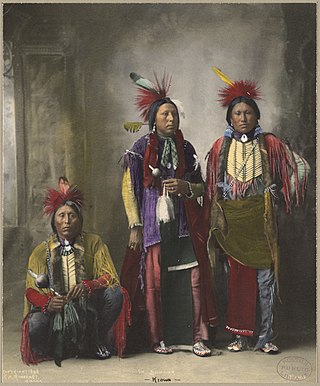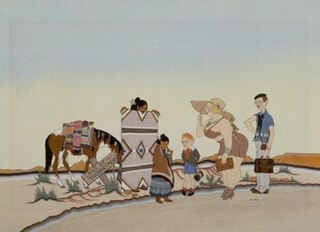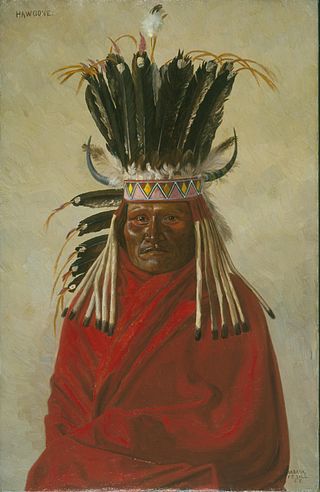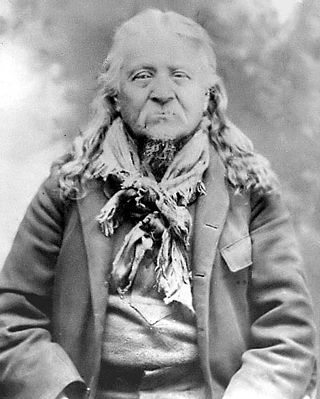
Kiowa or CáuigúIPA:[kɔ́j-gʷú]) people are a Native American tribe and an Indigenous people of the Great Plains of the United States. They migrated southward from western Montana into the Rocky Mountains in Colorado in the 17th and 18th centuries, and eventually into the Southern Plains by the early 19th century. In 1867, the Kiowa were moved to a reservation in southwestern Oklahoma.

Gilcrease Museum, also known as the Thomas Gilcrease Institute of American History and Art, is a museum northwest of downtown Tulsa, Oklahoma housing the world's largest, most comprehensive collection of art of the American West, as well as a growing collection of art and artifacts from Central and South America. The museum is named for Thomas Gilcrease, an oil man and avid art collector, who began the collection. He deeded the collection, as well as the building and property, to the City of Tulsa in 1958. Since July 1, 2008, Gilcrease Museum has been managed by a public-private partnership of the City of Tulsa and the University of Tulsa. The Helmerich Center for American Research at Gilcrease Museum was added in 2014 at a cost of $14 million to provide a secure archival area where researchers can access any of the more than 100,000 books, documents, maps and unpublished materials that have been acquired by the museum.

Woodrow Wilson Crumbo (Potawatomi) was an artist, Native American flute player, and dancer who lived and worked mostly in the West of the United States. A transcript of his daughter's interview shows that Mr. Crumbo was born on January 31, 1912, so there is a discrepancy of the date until confirmation. As an independent prospector in New Mexico in the late 1950s, he found one of the largest beryllium veins in the nation, valued at millions of dollars.

For state legislator of Borth Carolina Alexander C. McIntosh see North Carolina General Assembly of 1899–1900

Ledger art is narrative drawing or painting on paper or cloth, predominantly practiced by Plains Indian, but also from the Plateau and Great Basin. Ledger art flourished primarily from the 1860s to the 1920s. A revival of ledger art began in the 1960s and 1970s. The term comes from the accounting ledger books that were a common source of paper for Plains Indians during the late 19th century.
The Kiowa Six, previously known as the Kiowa Five, is a group of six Kiowa artists from Oklahoma in the early 20th century, working in the "Kiowa style". The artists were Spencer Asah, James Auchiah, Jack Hokeah, Stephen Mopope, Monroe Tsatoke and Lois Smoky.
Archie Blackowl was a Cheyenne painter from Oklahoma who played a pivotal role in mid-20th century Native American art. "Leave a mark. Put something down so that when the young people see it they will understand." –Archie Blackowl, July, 1975

Silver Horn or Haungooah (1860–1940) was a Kiowa ledger artist from Oklahoma.
James Auchiah (1906–1974) was a Kiowa painter and one of the Kiowa Six from Oklahoma.
Monroe Tsatoke (1904–1937) was a Kiowa painter and a member of the Kiowa Six from Oklahoma.
Stephen Mopope (1898–1974) was a Kiowa painter, dancer, and Native American flute player from Oklahoma. He was the most prolific member of the group of artists known as the Kiowa Six.

"John Wilson the Revealer of Peyote" (c.1845–1901) was a Caddo medicine man who introduced the Peyote plant into a religion, became a major leader in the Ghost Dance, and introduced a new peyote ceremony with teachings of Christ. John Wilson's Caddo name was Nishkû'ntu, meaning "Moon Head."
The Bacone school or Bacone style of painting, drawing, and printmaking is a Native American intertribal "Flatstyle" art movement, primarily from the mid-20th century in Eastern Oklahoma and named for Bacone College. This art movement bridges historical, tribally-specific pictorial painting and carving practices towards an intertribal Modernist style of easel painting. This style is also influenced by the art programs of Chilocco Indian School, north of Ponca City, Oklahoma, and Haskell Indian Industrial Training Institute, in Lawrence, Kansas and features a mix of Southeastern, Prairie, and Central Plains tribes.

Carl Sweezy (1881–1953) was a Southern Arapaho painter from Oklahoma. He painted individual portraits, but was best known for his portrayals of ceremonies and dances.
Jason Baird Jackson is an American anthropologst who is Professor of Folklore and Anthropology at Indiana University Bloomington. He is "an advocate of open access issues and works for scholarly communications and scholarly publishing projects." At IUB, he has served as Chair of the Department of Folklore and Ethnomusicology and as Director of the Folklore Institute. According to the Journal of American Folklore, "Jason Baird Jackson establishes himself as one of the foremost scholars in American Indian studies today."

Museum anthropology is a domain of scholarship and professional practice in the discipline of anthropology.

Marcelle Sharron Ahtone Harjo is a Kiowa painter from Oklahoma. Her Kiowa name, Sain-Tah-Oodie, translates to "Killed With a Blunted Arrow." In the 1960s and 1970s, she and sister Virginia Stroud were instrumental in the revival of ledger art, a Plains Indian narrative pictorial style on paper or muslin.
Victor Griffin was the elected chief of Quapaw Tribe of Indians and a peyote roadman from Quapaw, Oklahoma. Griffin was commonly called either Victor or Vic, and rarely used his first name, William. He conferred with every U.S. president during his term as chief.

Big moon peyotism was introduced as a variant of the Peyote religion in the 1880s that incorporated Christian, Caddo, and Delaware religious symbols with the consumption of peyote intertwined from Caddo and Delaware rituals. The plant itself, peyote, had been used for spiritual practice by the Mescalero Apache in the 1880, and their use of it influenced other tribes like the Comanche and Kiowa. Peyotism inquires all of the same traits found in other religions such as a doctrine, a ritual, and ethics. The doctrine includes the belief of the actuality of power, incarnation, and spirits. It soon spread all over the Indian Territory while its native people were searching for spiritual help. Peyotism at this point, was a spiritual path that was soon to be taken in Indian Territory. Around 1890, the Caddo, Delaware and Quapaw tribes became the first practitioners of peyote. Black Wolf, a practitioner from the Caddo tribe, brought the religion of little moon peyotism to the Osage people. Black Wolf had intrigued enough of the tribe that his peyote prayers and rituals had truth and value, so the people sent him to heal a sick person in their tribe. His prayers and rituals could not save their life, so peyotism was not being spread for a while. After the native people's dry spell towards peyotism, it returned to the Osage tribe around 1898.

Yatika Starr Fields is a Native American painter, muralist and street artist, born in the city of Tulsa, Oklahoma. His artworks were shown at numerous galleries and museums, including the APEC Young Artist Exhibition and recently in the Sam Noble Museum.











